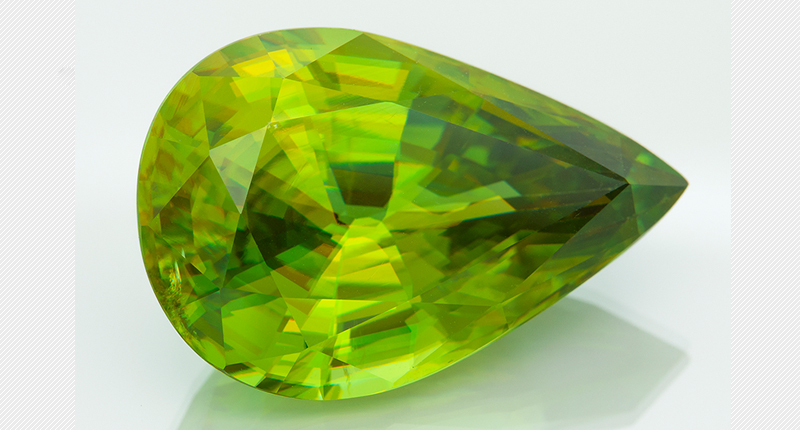“Bridgerton” actresses Hannah Dodd and Claudia Jessie star in the brand’s “Rules to Love By” campaign.
5 Things To Know About … Sphene
Discover what gives the gem a fire that can out-sparkle a diamond, its second name, geographic origins, and more.

I, for one, love when the gemstone is a vibrant, almost lime green that also shows flashes of orange and yellow.
Sphene belongs to the titanite mineral group, occurring as an accessory mineral in granitic and calcium-rich metamorphic rocks, and is the only member of the group commonly used in jewelry.
Here are five things to know about this unique gemstone.
1. It has another name.
Sphene comes from the Greek word “sphenos,” meaning wedge, a reference to the mineral’s characteristic wedge-shaped crystals.
But it also goes by the name titanite, referencing its place in the mineral group.
According to many online sources, “sphene” is more commonly used in the gem and jewelry sector while geologists and mineralogists tend to use “titanite.”
2. Gem-quality examples are rare.
Sphene is a collector’s gem and is particularly rare when you start talking about a clean stone above 5 carats, the International Gem Society says.
As is the case with all gemstones, size creates a premium with this species.
3. It has more “fire” than a diamond.
Sphene has one of the highest dispersions of any mineral; the term dispersion refers to a mineral’s ability to break white light into spectral colors.
The dispersion of sphene is 0.051. A diamond’s dispersion, by comparison, is 0.044.
It’s this high number that helps to give the stone such an intense “fire,” showcasing multiple colors, especially when it’s well-cut.
Sphene has a refractive index of 1.843-2.110 and a birefringence of 0.100-0.192. Its high birefringence often results in visible doubling of facets within the stone, meaning there looks to be a “fuzziness” inside the gem.
It’s a 5 to 5.5 on the Mohs scale, making it softer than other, more well-known gems like sapphire, ruby and even garnet.
Sphene has distinct cleavage in one direction, but can still create beautiful jewelry when cut and set properly.
It’s also pleochroic, showing more than one color depending on the angle from which you view it; sphene’s transparent specimens are notable for their trichroism, showing three different colors.
The three colors depend on the base stone color, according to Gemdat.org.

4. It comes in a variety of hues, but some are preferred.
According to IGS, there’s a preference in the market for lighter tones, especially the yellows, light oranges and greens, which best show off the gemstone’s amazing dispersion.
IGS also notes that “chrome sphene”—dark green in color—is the most valuable type as its hue mimics a good emerald.
5. Here are its sources.
The primary sources of sphene are Canada, Madagascar and Mexico, IGS says.
Baja California, Mexico produces yellow-brown, brown, green and dark green (chrome) crystals up to 4 inches long, making it one of the world’s main sphene deposits.
Madagascar produces green crystals, some of which are large in size, while Canada produces brown and black crystals.
IGS added that Austria and Switzerland also have both produced sphene.
Other places where sphene has been found are: India, Sri Lanka, Afghanistan, Germany, Kenya, Myanmar, Pakistan, Russia, New York state and Minas Gerais, Brazil.
The Latest

Founded by jeweler and sculptor Ana Khouri, the brand is “expanding the boundaries of what high jewelry can be.”

The jewelry manufacturer and supplier is going with a fiery shade it says symbolizes power and transformation.

How Jewelers of America’s 20 Under 40 are leading to ensure a brighter future for the jewelry industry.

The singer-songwriter will make her debut as the French luxury brand’s new ambassador in a campaign for its “Coco Crush” jewelry line.


The nonprofit’s new president and CEO, Annie Doresca, also began her role this month.

As the shopping mall model evolves and online retail grows, Smith shares his predictions for the future of physical stores.

Roseco’s 704-page catalog showcases new lab-grown diamonds, findings, tools & more—available in print or interactive digital editions.

The trade show is slated for Jan. 31-Feb. 2 at The Lighthouse in New York City's Chelsea neighborhood.

January’s birthstone comes in a rainbow of colors, from the traditional red to orange, purple, and green.

The annual report highlights how it supported communities in areas where natural diamonds are mined, crafted, and sold.

Footage of a fight breaking out in the NYC Diamond District was viewed millions of times on Instagram and Facebook.

The supplier has a curated list of must-have tools for jewelers doing in-house custom work this year.

The Signet Jewelers-owned store, which turned 100 last year, calls its new concept stores “The Edit.”

Linda Coutu is rejoining the precious metals provider as its director of sales.

The governing board welcomed two new members, Claire Scragg and Susan Eisen.

Sparkle with festive diamond jewelry as we celebrate the beginning of 2026.

The master jeweler, Olympian, former senator, and Korean War veteran founded the brand Nighthorse Jewelry.

In its annual report, Pinterest noted an increase in searches for brooches, heirloom jewelry, and ‘80s luxury.

Executive Chairman Richard Baker will take over the role as rumors swirl that a bankruptcy filing is imminent for the troubled retailer.

Mohr had just retired in June after more than two decades as Couture’s retailer liaison.

Shekhar Shah of Real Gems Inc. will serve as president of the Indian Diamond & Colorstone Association in 2026.

This year’s good luck charm features the mythical horse Pegasus, and is our first Piece of the Week of the new year.

As part of the leadership transition, Sherry Smith will take on the role of vice president of coaching strategy and development.

It marks the third time the country has headed the Kimberley Process. Ghana will serve as vice chair.

The new Bulova x Stetson designs highlight two animals often associated with the American West—the bison and the Texas Longhorn.

Its residency at Yamron Jewelers will run through May 2026.




























